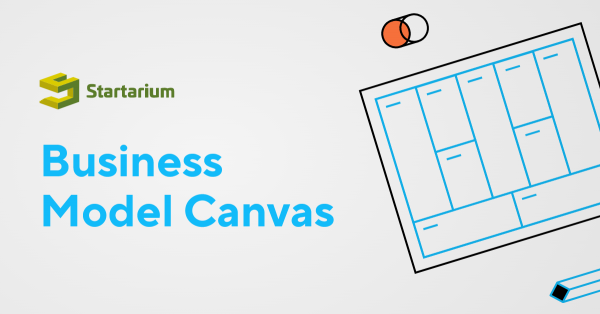A common confusion entrepreneurs tend to encounter in their earliest stages is considering that a business model canvas is in fact also a business plan. They are in fact different but they are also connected.

Before you get down to business, you should first have a clear view of your business model and you also try to simulate how it will work the best for you. You should take some decisions about how to maintain the balance in your activity, based on the resources you need and the growth opportunities that come along the way. Here is what you need to know about the business model and the business plan.
If you are wondering how to make more money so that you can reach more clients, well a starting point is your very own business model canvas. You can use it to make decisions by using the 9 strategic themes from the business model canvas, which we’ve covered in the previous article.
What’s crucial to understand first are your options and their impact on the first 2 great challenges you face in entrepreneurship:
- Having the right product for the right market
- Having a viable business model
Having the right product for the right market is, in other words, the product-market fit concept.
The first challenge is to ensure that your offer is of real value to the type of customers you are targeting. Here are some important insights to help you make this process a lot easier:
1. Explore all possibilities. Have a brainstorming on the types of clients you look for and make a comparison (e.g. How many types of clients are there? How can I reach more of them? Do you have the resources?) and then:
- Think of different variations of your product
- Look for all the products your client might use and say “Ok, this is perfect for me” (even though they might be very different from your solution/product)
- Look for all the ways in which you can promote and monetize your business
- Lastly, “draw” as many business models as possible and validate them one by one, (also consider including the following actions).
2. Interview your (potential) clients: find out all about how they deal with things, why they make certain choices and what are some of their struggles. Tip: use open questions and be genuinely curious.
3. Build a prototype: sketch, build and ask people to use your product so that you can check if your assumptions were correct. At the same time, this will allow you to discover problematic aspects or valuable insights you didn’t consider at first.
Don’t restrain yourself while prototyping. Prototypes come in many shapes and sizes, such as:
- a wireframe / a sketch
- an not-so-pretty but functional version :)
- promotional materials
- a user storyboard
- a demo experience
- a complete version, ready to be put up on the shelves
- a commercial that tests your clients’ reaction to your idea
4. Give your clients the opportunity to test your prototype. Unfortunately, the simpler the prototype, the more incomplete the information you’re receiving – despite this fact, it’s better to discover at the right time which of your theories was unrealistic.
5. Build a complete experience: from the way your clients find out about you, to when they decide and the moment they buy your product/service - these are all important aspects to consider. Make sure you’re further developing the product while building on their behaviors and needs.
Your business may become sustainable if you find a suitable product-client cycle and if you develop a good sales strategy.
Make sure you also take into consideration that:
- The distribution channels and the monetization model generate sales and make the relation with the clients easier, more efficient and recurrent
- The costs generated by the resources, activities and partners you need don’t actually exceed the income (because in this case you won’t be able to get any profit)
Here are some tips on how you can face this challenge:
- Is “How I pay” more important than “How much I pay”. Here you need to understand which monetization model is most suitable for your clients: subscriptions per month or per user? One-time purchase? Renting? Etc. Then, find out how much they are willing to pay.
- Understand what it means to sell and the actual cost of selling: read about it, study or ask what different channels and opportunities can (and most importantly, what they cannot) do for your business and finally, how much they cost.
- Make sure you know all your costs: for each potential business model, make a list of costs and start estimating how much you will pay. There are no right or wrong lists and what’s important is to have a “living” document, which evolves along with your decisions.
- Estimate your revenues: estimating your revenues is probably the most difficult exercise, especially when you don’t have all the pieces of the puzzle. However, what you can do before anything else is to draw different business models in a spreadsheet and add information and estimations, just as you’d do for the costs, as you begin to have a better understanding of the market.
- Compare costs & revenue: it might look like an obvious exercise, but most entrepreneurs do this when it’s already a bit too late. Even if you’re starting with few (and sometimes wrong) info, you can figure out on time if some business models are not viable and what decisions you can take from there.
Where does the business plan come to play?
First, we need to clarify a few terms:
- Planning for your business is the process of taking all the decisions stated above and to finally “learn” everything you need to know about your business or industry
- The business plan is the instrument which “tells” you what are the best decisions you can make.
In other words, you will always do the business planning – you’re doing it equally whether you’re taking everyday decisions or you’re deciding about what’s happening in the next 2 years. You will use the business plan when you need to better communicate or visualize your decisions.
Some pieces of advice that are useful to most entrepreneurs:
- Make sure you're directing your efforts towards selling something. In most cases, the issues you face during a sale turn out to be way more helpful along the way than the mistakes that only occur on paper.
- It might help if you get some basic business knowledge, so that it becomes easier for you to find new possibilities and come up with new ideas. Stay up to date with all the new technologies, markets, business models and different business approaches and products in all industries. This should however be an everyday practice, and not something you only do when you’re thinking of releasing something new.
- Even though your product gets “approval” from your first clients, don’t expect to reach everyone though paid campaigns. Marketing channels are getting more and more expensive, so make sure your business model has some alternative channels that bring new clients: word of mouth, organic, partnerships etc.
- Don’t underestimate the initial investment you need to bring your first clients. Without a good marketing budget, it will be more difficult (if not impossible) to have a good start.
- Remember to go further and invest only after you've gathered some answers for your business model. Until then, most of your marketing expenses will likely just be experimental.























